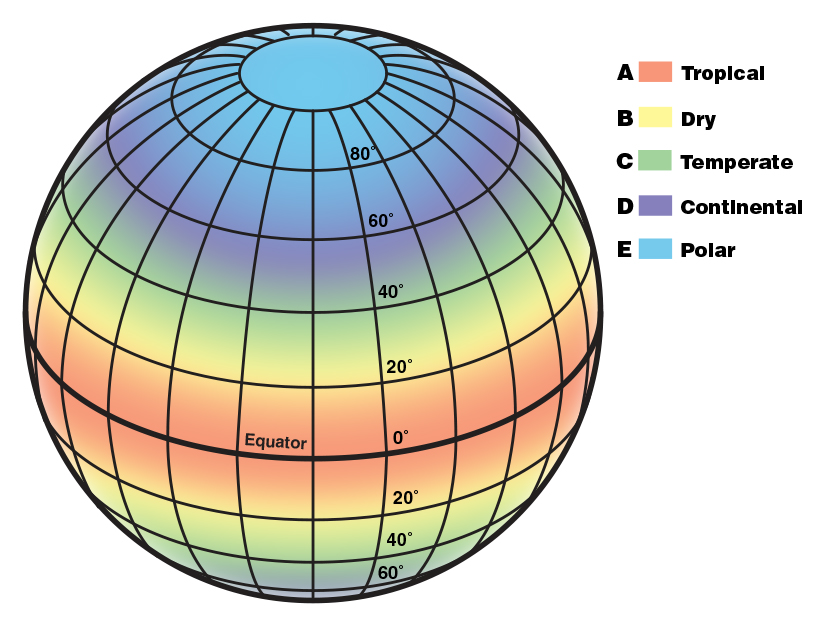Describe climates in different regions of the world
Practice Questions
3rd Grade Science › Describe climates in different regions of the world
Which answer choice is the best description of the climate in a tropical zone based on the graphs provided?


The National Oceanic and Atmospheric Administration describes the five main types of climates. They are:
A: Tropical. In this hot and humid zone, the average temperatures are higher than 64°F (18°C) year-round, and there are more than 59 inches of precipitation each year.
B: Dry. These climate zones are so dry because moisture is rapidly evaporated from the air, and there is very little precipitation.
C: Temperate. In this zone, there are typically warm and humid summers with thunderstorms and mild winters.
D. Continental. These regions have warm to cool summers and very cold winters. In the winter, this zone can experience snowstorms, strong winds, and very cold temperatures—sometimes falling below -22°F (-30°C)!
E: Polar. In the polar climate zones, it’s extremely cold. Even in summer, the temperatures here never go higher than 50°F (10°C)!


Which climate zone is NOT found in the United States?
The National Oceanic and Atmospheric Administration describes the five main types of climates. They are:
A: Tropical. In this hot and humid zone, the average temperatures are higher than 64°F (18°C) year-round, and there are more than 59 inches of precipitation each year.
B: Dry. These climate zones are so dry because moisture is rapidly evaporated from the air, and there is very little precipitation.
C: Temperate. In this zone, there are typically warm and humid summers with thunderstorms and mild winters.
D. Continental. These regions have warm to cool summers and very cold winters. In the winter, this zone can experience snowstorms, strong winds, and very cold temperatures—sometimes falling below -22°F (-30°C)!
E: Polar. In the polar climate zones, it’s extremely cold. Even in summer, the temperatures here never go higher than 50°F (10°C)!

How would the climate of MOST of Africa be described?
Source: https://scijinks.gov/climate-zones/ & http://www.webquest.hawaii.edu/kahihi/sciencedictionary/C/climatezone.php
What type of characteristics would be included in a description of the climate in a region?
How would you describe the temperature in an arctic climate (Nuuk, Greenland) compared to a tropical climate (Nosy Be, Madagascar)?


The National Oceanic and Atmospheric Administration describes the five main types of climates. They are:
A: Tropical. In this hot and humid zone, the average temperatures are higher than 64°F (18°C) year-round, and there are more than 59 inches of precipitation each year.
B: Dry. These climate zones are so dry because moisture is rapidly evaporated from the air, and there is very little precipitation.
C: Temperate. In this zone, there are typically warm and humid summers with thunderstorms and mild winters.
D. Continental. These regions have warm to cool summers and very cold winters. In the winter, this zone can experience snowstorms, strong winds, and very cold temperatures—sometimes falling below -22°F (-30°C)!
E: Polar. In the polar climate zones, it’s extremely cold. Even in summer, the temperatures here never go higher than 50°F (10°C)!

In what climate zone can Antarctica be found?
Source: https://scijinks.gov/climate-zones/ & http://www.webquest.hawaii.edu/kahihi/sciencedictionary/C/climatezone.php
The National Oceanic and Atmospheric Administration describes the five main types of climates. They are:
A: Tropical. In this hot and humid zone, the average temperatures are higher than 64°F (18°C) year-round, and there are more than 59 inches of precipitation each year.
B: Dry. These climate zones are so dry because moisture is rapidly evaporated from the air, and there is very little precipitation.
C: Temperate. In this zone, there are typically warm and humid summers with thunderstorms and mild winters.
D. Continental. These regions have warm to cool summers and very cold winters. In the winter, this zone can experience snowstorms, strong winds, and very cold temperatures—sometimes falling below -22°F (-30°C)!
E: Polar. In the polar climate zones, it’s extremely cold. Even in summer, the temperatures here never go higher than 50°F (10°C)!

The United States is primarily in the temperate zone, excluding Alaska and Florida, which are in which zones?
Source: https://scijinks.gov/climate-zones/ & http://www.webquest.hawaii.edu/kahihi/sciencedictionary/C/climatezone.php
Which answer choice is the best description of the climate in a temperate zone based on the graphs provided?


The National Oceanic and Atmospheric Administration describes the five main types of climates. They are:
A: Tropical. In this hot and humid zone, the average temperatures are higher than 64°F (18°C) year-round, and there are more than 59 inches of precipitation each year.
B: Dry. These climate zones are so dry because moisture is rapidly evaporated from the air, and there is very little precipitation.
C: Temperate. In this zone, there are typically warm and humid summers with thunderstorms and mild winters.
D. Continental. These regions have warm to cool summers and very cold winters. In the winter, this zone can experience snowstorms, strong winds, and very cold temperatures—sometimes falling below -22°F (-30°C)!
E: Polar. In the polar climate zones, it’s extremely cold. Even in summer, the temperatures here never go higher than 50°F (10°C)!


What region of the United States would be the most likely to feature deserts?
How would you describe the temperature in a tropical climate (Nosy Be, Madagascar) compared to a temperate climate (Omaha, Nebraska)?

